Vegetarian Christmas Menu
Starter: Roasted tomato soup (vegan)
Main: Mushroom Wellington (vegetarian/vegan)
Dessert: Orange Spice Cake (vegetarian)
Sides: Butternut gratin, roast potatoes and root vegetables, sweet potato and ginger mash
Last Christmas, as it happens, I didn't give someone my heart, but I did make a superb Sweet potato, hazelnut and spinach en croûte from the Cornucopia cookbook. I wanted to try something different this year, to add to my repertoire, for when I am in a position to throw candlelit dinners.
(FYI: I prepared all my vegetables, par-boiled the potatoes for roasting as well as making the soup and gravy the day before, to save on stress on Christmas day.)
Roast Tomato Soup
(from Rachel Allen: Home Cooking)
900g ripe tomatoes (about 8), halved
1 red onion, peeled and thickly sliced
6 large cloves of garlic, peeled
Leaves from 4 sprigs of thyme
1 tsp caster sugar
2 Tbsp extra virgin olive oil
1 Tbsp balsamic vinegar
Sea salt & freshly ground black pepper
600ml vegetable stock
50ml double or regular cream (I used Provamel soy cream)
Basil leaves, to serve
1. Preheat your oven to 200C. Cut the tomatoes in half and arrange the halves, cut side up, in a single layer on a baking tray and scatter over the onion, garlic, thyme and sugar. Drizzle over the olive oil and balsamic vinegar and season with salt and pepper.
2. Roast in the oven for 35-40 minutes or until softened. Once cooked, tip the entire contents of the baking tray, including any juices, into a blender. Add the stock and blend until smooth, then pour into a large saucepan. Alternatively, place the cooked tomatoes in the saucepan, pur in the stock and puree using a hand held blender.
3. Bring the soup to the boil, add the cream, reduce the heat and simmer for a few minutes to heat through. Serve topped with basil leaves.
I can't take credit for this, as my 17 year old brother made this! We had it with toasted spelt bread from Mayo's Cherry Blossom Bakery, spread with Pure dairy free margarine.
This dish is time-consuming, but you can prepare it up to the baking stage and freeze it weeks in advance. Before serving, remove the wellington from the freezer and, after thawing, glaze the pastry with beaten egg (or without if vegan) and put it in a hot oven to bake for 45 minutes at 220C/425F/gas mark 7 until puffed and golden.
Mushroom Wellington
Makes 2
600g puff pastry (I used read-rolled pastry, Jus Rol is suitable for vegans)
50ml flavourless vegetable oil
675g chopped onions
450g whole chestnut mushrooms
2 tbsp fresh or dried tarragon
4 garlic cloves, crushed
4 tbsp soya sauce or tamari, or replace one with marsala or sherry
320g broken cashew pieces
320g ground almonds
175g fine freshly made breadcrumbs, white or wholemeal
1 egg, beaten for glazing (omit for vegans)
salt and pepper to taste
1. Roll out the pastry into two rectangles, 23x30.5cm each, cover and place in the fridge, if you're using ready made, no need to do this as its all been done for you! To make the filling, heat the oil in a large pan and fry the onion with half the crushed garlic for at least 20 minutes or until it turns a deep golden colour.
2. Remove onions from the pan and set aside, then add the mushrooms to the same pan with the rest of the garlic and half the tarragon and cook on a fairly high heat. Halfway through cooking, add the soya sauce or tamari and the alcohol, if you are using it. Continue until the mushrooms are cooked through; there should be no white centre left when you cut one open.
I cut mine in two halfway through cooking to ensure they were cooked throughly.
3. Season with salt and pepper. Set aside, reserving all the mushroom liquor (the intensely flavoured liquid given out by the mushrooms). If you have too little liquid, add some water to the pan and swirl around until it combines with the mushroom liquid. In a food processor or blender, blend the cashews with the reserved mushroom liquor to a fine, smooth purée, adding a little water or even more of whichever alcohol you are using, until you have a smooth, sweet paste or pate.
4. Remove mixture from the blender and blend first the onions, then mushrooms – you can mix them up if you wish – until they are perfectly smooth. Mix all the blended ingredients together in a bowl, adding the breadcrumbs, ground almonds and the remaining tarragon. The mixture should gently hold its shape when formed with the hands. Heat the oven to 220C/425F/gas mark 7. Remove the pastry from the fridge.
5. Divide the mixture in two and place one lot on a sheet of pastry, shaping with your hands as you go to make a long rectangular shape about 28cm long, 7cm wide and about 5cm high. With the thin point of a sharp knife, make diagonal cuts at a 45-degree angle, starting from the left hand corner of the pastry towards the pate mixture. Repeat on the other side, this time starting at the top right hand corner and cutting down towards the centre.
6. The strips should now be about 2cm apart. Fold in the end pieces first. Then draw a strip over from the left, then one from the right, crossing them over so the mix is snugly wrapped up. Repeat for the second wellington.
Either freeze at this stage or glaze generously with beaten egg. Place upon a floured tray, using two fish slices or the loose base of a tart tin to help you.
7. Bake in the preheated oven for 35 to 45 minutes until golden. Allow to cool for a few minutes before attempting to lift onto a serving dish. Allow 2 slices per person, cut with a very sharp serrated knife.
To serve
Place the wellington on your large platter, surrounded by roasted vegetables. I made a red wine and juniper gravy, from the Cornucopia cookbook, you can find the recipe here.
This recipe was originally conceived by Nadine Abensur.
Behold, a totally uncurated picture of my decadent Christmas dinner, piled high with butternut gratin, mushroom wellington, roasted veg & potatoes, sweet potato & ginger mash and red wine & juniper gravy
Seasons Greetings everyone!
The Shop, Chelsea
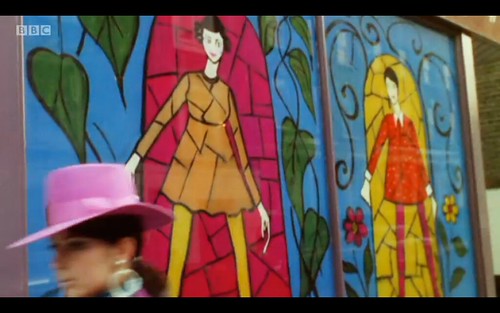
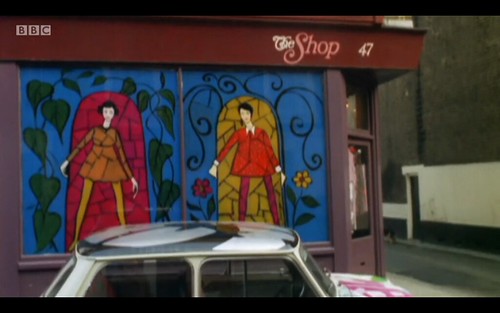

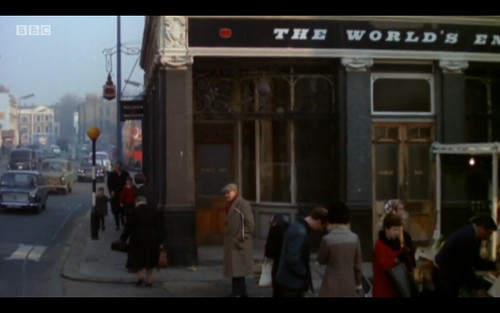
Granny Takes a Trip, 488 Kings Road, Chelsea (Read)
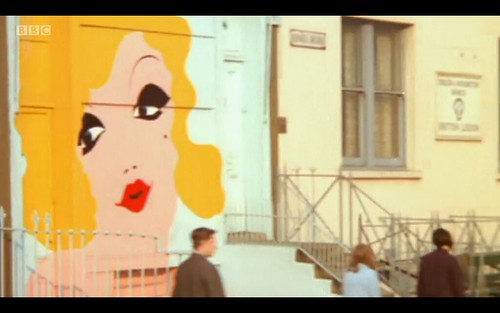
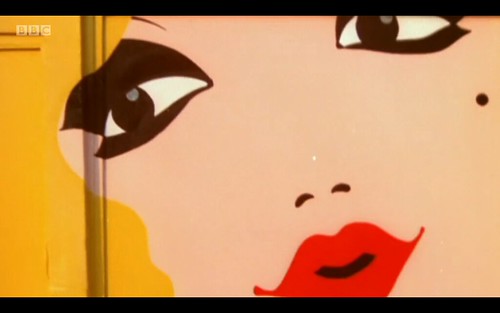
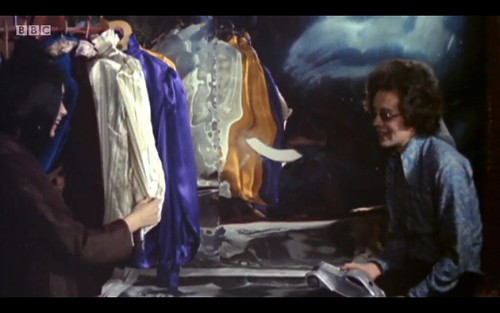

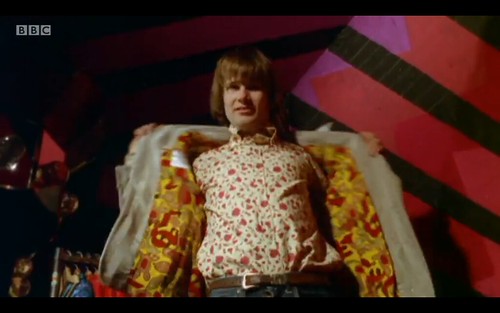
The Antiques Supermarket (predecessors to today's vintage shops)
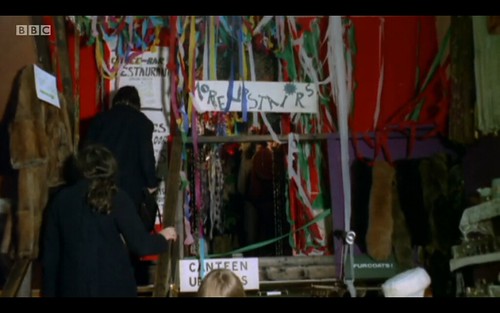

I Was Lord Kitchener's Valet, 293 Portobello Road, W10 (Read)
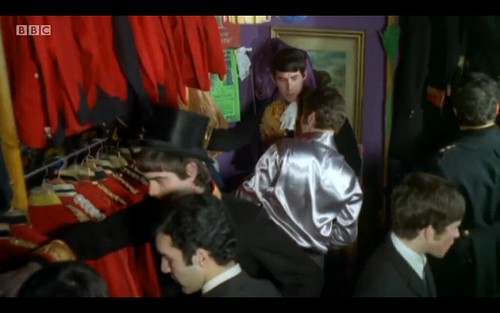

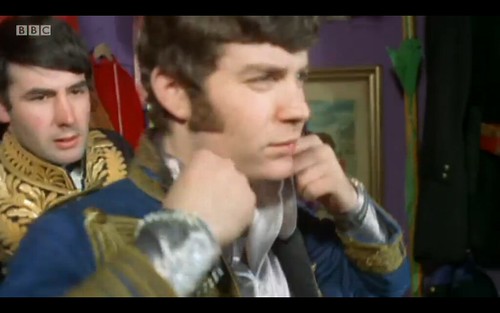
Other clothing stores on Carnaby Street and Kings Road
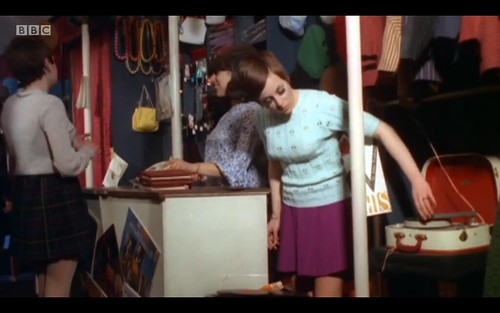

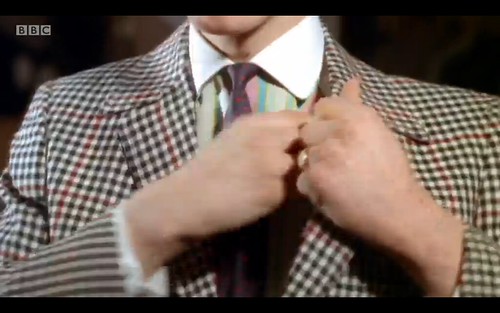
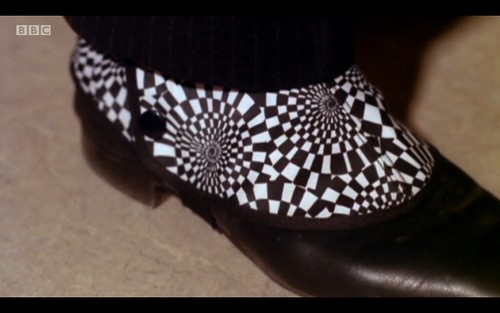
Nightclubs - Tiles, Flamingo Club, UFO Club
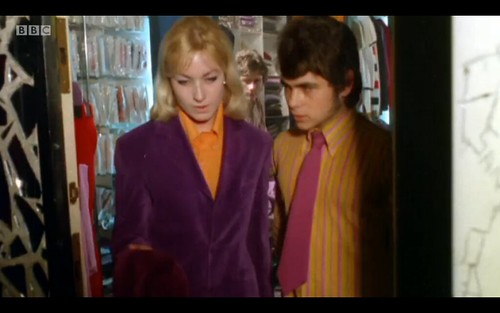
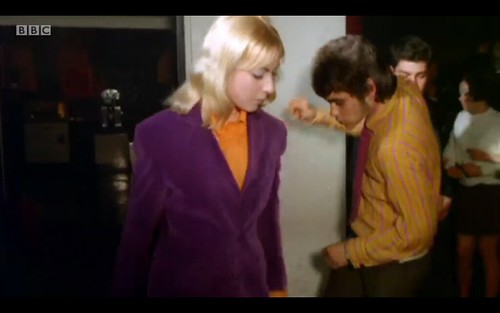
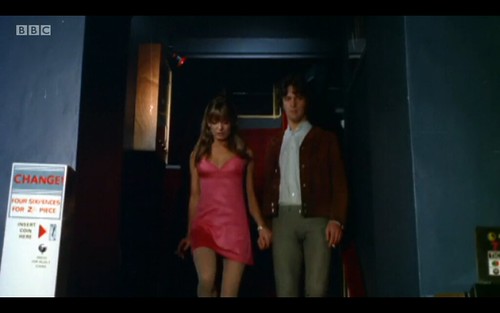

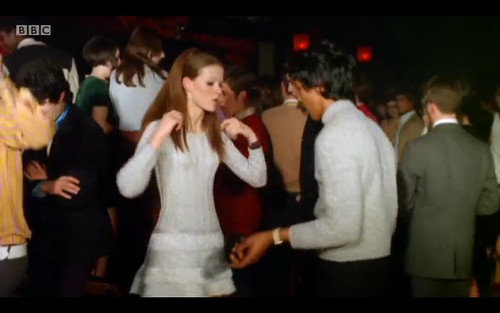
BBC iPlayer have some great documentaries that you can watch up to a week or two weeks after they've aired on TV. As I'm in Ireland I couldn't previously watch these online, but a friend suggested a plugin for Google Chrome and Firefox called Media Hint. It takes mere minutes to install and within half an hour I had access to some great docs, including the above BBC4 'Timeshift' series doc Britain on Film: Dedicated Followers of Fashion focusing on the fashions of the 1960s. In this documentary series they take the footage of 'Look at Life', a regular British series of short documentary films of which over 500 were produced between 1959 and 1968 by the Special Features Division of the Rank Organisation for screening in their Odeon and Gaumont cinemas.
It portrays everything that was exciting about the early to mid 1960s, I love the Dandy fashions for men, those jackets, those linings! The explosions of colour, the mix of the antique with the modern. It always seems so strange to me, what we consider antique now were relative to them, as to how we regard the fashions our parents wore. Edwardian, art deco clothing would have been much easier to get a hold of them, and at much reduced prices to now. I think this one of the many reasons why I hold such a nostalgia for that period of time, of seismic change. Of course, if I had been growing up in rural Ireland then I wouldn't have had those opportunities to act out, unless I became a nurse and moved to London as many generations of Irish women before me have done. Lets not forget that the rent was affordable then! Such an exciting time appeals to me, as in the midst of a recession, as a young person I feel a lot around me is stagnant, but the prices are higher than ever.
I think my favourite outfits above is the girl in the purple velvet jacket with the orange shirt, two of my favourite colours, she looks so sharp and confident! I love the arts and crafts inspired window of The Shop, with a mod twist! Perhaps I am viewing that period through rose-tinted glasses, but even watching the nightclub footage it seems that efforts were made for a social purpose, and not a commercial one. If you walk through Chelsea today, you'll see what I mean.
You can view my full flickr album here.
If the above pictures have caught your interest you can watch the 30min documentary on YouTube (as I only discovered this afternoon):

Last week I got a bit of a shock, as I discovered I was a finalist in 'Arts and Culture' category in the Blog Awards Ireland 2013! There are four other fabulous finalists in the same category, some of them personal favourites including The Irish Aesthete, writing.ie, A Year of Festivals in Ireland and Lexicolatry. Honestly, to be even uttered in the same breath as these fine blogs, is a reward in itself! It has really encouraged to push harder with my blog, so perhaps some changes will be on the horizon in the near future. For now, I'll continue to blog about my cultural pursuits and interests, (on a budget!). You know, I'm happy that even some of my friends read my blog! I have considered doing some freelance writing because theres still a lot I'd like to contribute, but this content doesn't necessarily 'fit' with the blog as it is, but I am unsure as to where to start, so if you have any suggestions feel free to comment or shoot me an email!
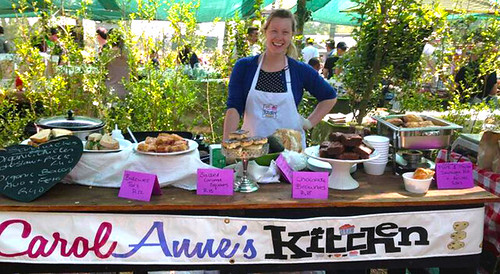
Carolanne with her produce at a market in Johannesburg (via)
Two other Sligo bloggers made it to the final round of nominations also, my friend Carolanne of Carol-Anne's Kitchen (for best Blog of the Dispora), and Seomra Ranga (Best Science/Education Blog). Carolanne is a globe trotting foodie, with a passion for life and new experiences. She has lived in India, Australia, and after training at the reknowned Ballymaloe cookery school earlier this year, she is currently based in South Africa, where she brings Irish flavours to the farmers markets of Johannesburg. The girl makes a mean caramel square. I mean I'm craving it right now, thousands of miles away, I've not tasted better yet, and I eat a lot of things coated in chocolate.

(via)
Seomra Ranga (from Irish, translates to 'class room') is an online resource, for Irish primary school teachers, established in 2007 by the enterprising Damien Quinn. It provides a wealth of free resources for teachers to use in the classroom, and Damien is active on every social network there is it seems, tirelessly promoting his fantastic site.
I wish them both well, both are duly dedicated to blogging and promoting their ideals just as well offline!
Blogging was a total revelation for me, I've made new friends along the way, though I'm not sure I can claim that my photography skills have improved! I find it enjoyable and immensely satisfying but I just don't blog enough! The Blog Awards Ireland is a reminder of the talent throughout this small island of ours, and no matter how rural or urban we bloggers are, we can connect with a blogging community on this world-wide platform, whether we're at home, or one of the thousands of Irish abroad, thinking of home.
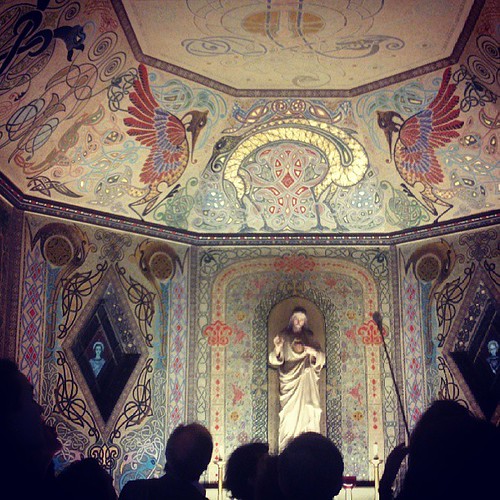
Vistors at the Oratory of the Sacred Heart, Dun Laoghaire, Co. Dublin
Open House Dublin, held annually in October, is Ireland's largest Architectural festival, running annually, part of the Architectural Festival Family worldwide which includes Chicago, London, Lisbon, Helsinki and Dublin. Last October, I volunteered in the North Georgian Quarter of Dublin and I wrote about my experiences here.
Overall participating in this weekend has been a rewarding experience. Over the three days, 100 buildings of historical, social and architectural interest open their doors to the public. This festival facilitates special tours by hundreds of professionals and enthusiasts to interested members of the public. Being a volunteer you get the opportunity to experience these special buildings, share them with the public and meet other interesting volunteers besides.
Rathmines Library

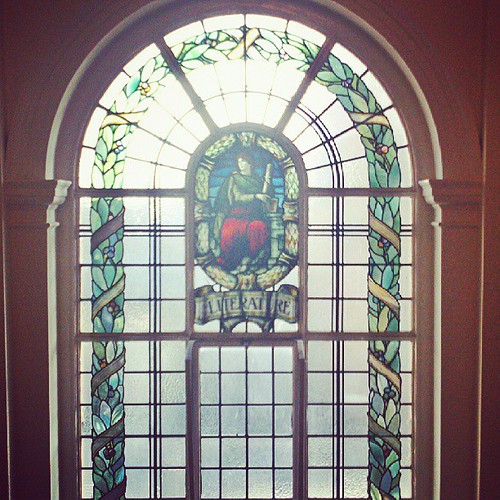

Top: Rathmines library celebrates its centenary this year
Middle: Morris & Co. 1913 stained glass window, with an allegory for literature.
Bottom: View of Rathmines towards Portobello from a library window.
On Saturday, I was based in Rathmines Library. This public library is the second busiest in Ireland, and was full of life all afternoon. It was cheering to see all the young families and various members of the community come through the doors. The stained glass window to the front of the building, was commissioned from William Morris & Co. in 1913, the simplicity of design is certainly in the Morris style. A classical figure is seated in the centre, as an allegory for literature. Rathmines Library is one of libraries funded by the Scottish-born philanthropist Andrew Carnegie. Carnegie's fortune is a true rags to riches story, coming from his successful steel business in the USA. Upon the sale of his business for $480m, he dedicated the rest of his life to philanthropic activities. He built the famous Carnegie Hall, and funded the establishment of public 'Carnegie libraries' throughout the English speaking world.
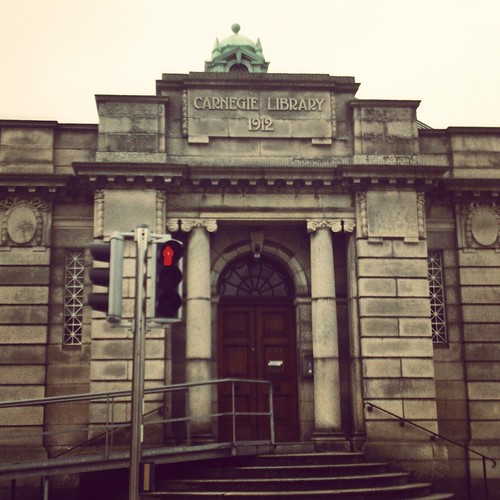
By great coincidence, or not, when I ventured out to Dun Laoghaire on Sunday, I discovered they too had a Carnegie Library!
Oratory of the Sacred Heart, Dun Laoghaire


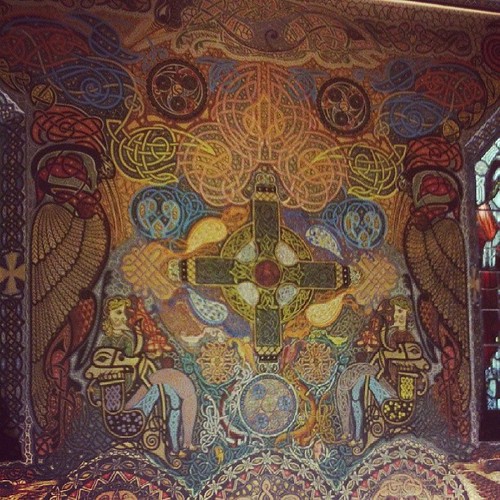
Top: Entrance to the Oratory of the Sacred Heart (c. 1919)
Middle: Mural detail of a Celtic figure
Bottom: Painted mural commemorating the 1932 Eucharistic Congress, which had taken place in Dublin
The journey from Dublin city centre takes about 50 minutes on a 46a bus, or 20 minutes on the DART. I was tied for time, as I had to get the last train back to Sligo on Sunday, but it was a beautiful mild afternoon, so I didn't mind the journey or the destination at all!
Sister Concepta Lynch (1874 - 1939, born Lily Lynch) learnt the Lynch Method of Celtic Art from her father, Thomas Joseph Lynch, a renowned Dublin artist who specialised in Celtic illuminations. After her father's death when she was 16, she ran his studio on Grafton street for a further six years, until taking her vows and becoming a nun in the enclosed order at the Dominican convent, Dun Laoghaire.
At the end of World War I, a town in Northern France donated a statue of the Sacred Heart to the parish of Kingstown (now Dun Laoghaire) to commemorate the many local Irishmen who had fought and died in Flanders during World War One. In response, in 1919, an oratory was commissioned by the Dominican sisters. Upon its completion, Sr Concepta was asked to decorate the altar, after witnessing the style in which she had executed it, her Mother Superior asked her to decorate the entire oratory, and she did so in the Celtic Revival style she had learnt from her father. She worked on the oratory for sixteen years (1920-1936), only giving up when she was in ill health towards the end of her life. As you can see from the pictures its not your conventional war/peace memorial!
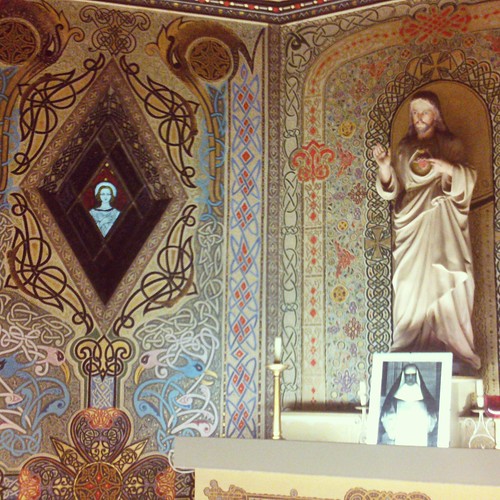

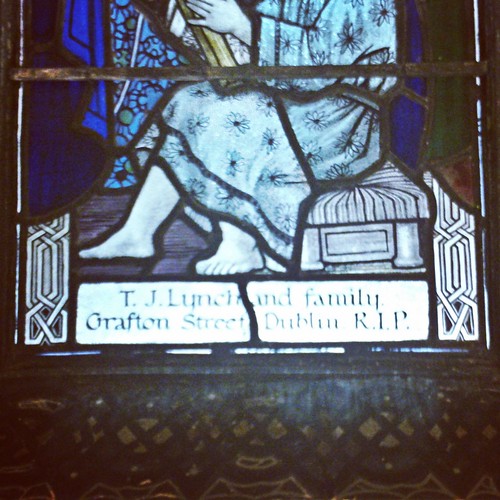
Top: The sacred heart statue was brought over from France after WWI, see the Harry Clarke & Co. stained glass in the background
Middle: The ceiling remains unfinished, after Lynch's death in 1939, Harry Clarke & Co. stained glass in the background
Bottom: The Harry Clarke & Co. stained glass was commissioned by Lynch, she had it inscribed with the names of family members who had helped fund and inspire her work in the oratory
The design of the oratory takes its inspiration from Celtic manuscripts, including the Book of Kells, as well as Byzantine methods of decoration. Celtic illuminations are notable for their zoomorphic designs (designs taking animal forms), figures, wonderfully curved designs and repeating patterns. This all encompassing design took Lynch sixteen years to complete between (1920-36), she became ill and couldn't complete the ceiling of the oratory. However, this does not detract from the design, as you can clearly see her design process, where she sketched out the designs in graphite pencil, using templates for repeating designs. Unbelievably the oratory is painted totally in household paint. As she was in an enclosed order she could not purchase the paints herself from a specialist art shop, so she would send her students with a list of her desired colours to the local shop to buy paints.
It is a shame that Lynch isn't more recognised in the Irish art canon. This is possibly due to a number of inter-related factors, significantly, she was in an enclosed order so she was not part of the artistic social scene in Dublin. The oratory itself was in a fixed location on the grounds of a convent in a coastal village outside Dublin, so its not like her life's work could be exhibited to the greater public.
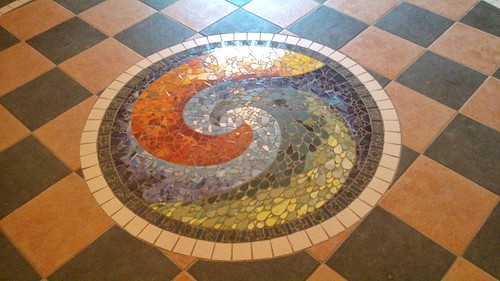
The modern building, or 'shell' that now surrounds the oratory was constructed in the 1990s in order to protect the small oratory. The entrance area has this beautiful mosaic set in the centre, by the artist Laura O'Hagan, who designed it in response to the Celtic Revival decoration of the oratory.
--
I apologise for the quality of my photos, it wasn't until I was on a train bound for Dublin that I realised I had forgotten my camera! Its difficult to source photos of the Oratory online, but I found some high resolution pictures of the oratory here on the Militaria Archive.
Rathmines library celebrates their cententary this year, and are hosting a number of fascinating (and free!) talks and events throughout October and November. View the full series of events on their site here.
Read more:
'The Gospel of Wealth' by Andrew Carnegie
Sister Concepta Lynch and the Lynch method of Celtic Art 1874 - 1939
View more high resolution pictures of the oratory here on the Militaria Archive
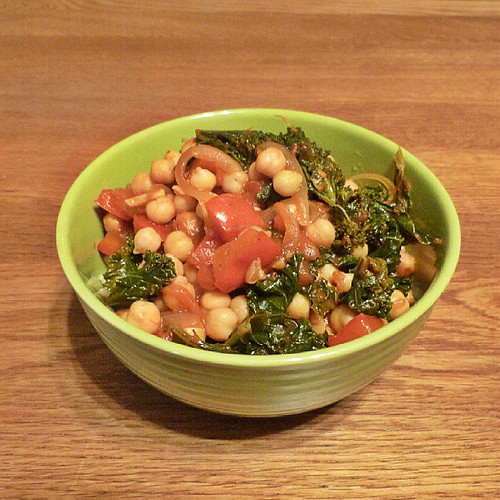
I never promised that Meat Free Monday would happen every Monday, but sporadically. Anyhow, I heartily enjoyed this kale and chickpea curry I made last week. My friend Jenny who has been rockin' veganism for the past few months recommended it to me. I adapted the original Vegan Society recipe.
Kale is currently is season at the moment, so buy Irish (or local to wherever you are)! You could always throw in some forgotten vegetables you have in the fridge, end of season courgettes would work well as they can be quite bland and would really benefit from the rich flavours of this curry (I'm so in love with the cardamon in this). As always this is a very economical dish to make.
Ingredients:
2 tablespoons rapeseed oil
2 medium onion, sliced
4 cloves of garlic, crushed
1 red pepper, diced
2 tins plum tomatoes
2 tins chickpeas
150ml vegetable stock
Pinch sea salt
200g kale
1/4 teaspoon chili flakes
1 teaspoon turmeric
1 teaspoon ground cumin
1 teaspoon ground coriander
6-8 cardamon seeds
Method:
- Heat the oil in a large saucepan and fry the sliced onion until golden. Add the garlic, pepper (optional) and spices (except for the cardamon) and stir every now and again while cooking for about 1 minute.
- Add tomatoes, drained chickpeas, kale and cardamon seeds. Bring to the boil and allow to simmer for 10-20 minutes until the kale has softened to your liking.
- Season to taste. Serve with rice, or naan bread.
- Should serve 4 people, generously, with enough leftover for lunch the next day!
The addition of cardamon really makes this dish special, and would keep for up to 3 days in the fridge for leftovers, I wouldn't recommend freezing as the kale would loose its texture.
You can view my other meat free monday recipes here.
Get involved in the #meatfreemonday campaign!

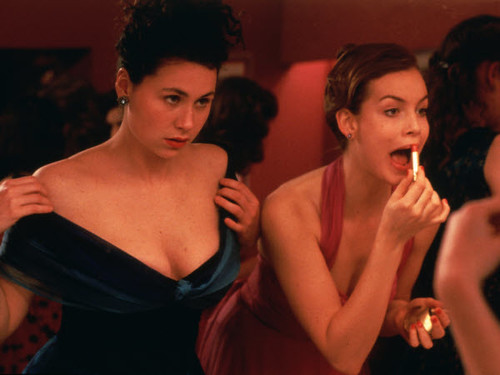
Minnie Driver and Saffron Burrows in the 1995 film adaptation of Binchy's bestselling novel Circle of Friends
As twenty somethings are loathe to do, a few weeks ago my friend Jean and I were dissecting our current situations (career, finances and relationships) and prospects for the future over tae. I'm trying to be positive and reflective with whatever hits me nowadays. We both see Maeve Binchy's book as a balm of sorts, as do generations of young Irish women, our mothers too.
Jean reached for her newly acquired kindle and brought my attention to a Binchy quotation she had highlighted in an article she had been reading. As with everything Binchy wrote, there's a sense of imparting wisdom, like a beloved aunt with a girlish heart, passing on her knowledge to make the difficulty of navigating your way through the obstacles of life a bit smoother, finding comfort in the knowledge that someone close to you grappled with similar situations, and came out the other side, warm personality intact.
"Learn to type. Learn to drive. Have fun. Write postcards. (Letters take too long and you won’t do it, a postcard takes two minutes.) Be punctual. Don’t worry about what other people are thinking. They are not thinking about you. Write quickly. (Taking longer doesn't usually make it better.) Get up early. See the world. Call everybody by their first name, from doctors to presidents. Have parties. Don’t agonise. Don’t regret. Don’t fuss. Never brood. Move on. Don’t wait for permission to be happy. Don’t wait for permission to do anything. Make your own life."

Maeve on the set of 'Circle of Friends', 1995. Binchy's international profile increased after her book was adapted into a film.
An ultimate autumn comfort of mine is curling up in my duvet before lights out and reading a chapter of a beloved Maeve Binchy book. I recently picked up a collection of her early short stories Dublin 4 in a charity shop, and read it on the train to Dublin. I lived in Dublin 4 for a time while I was an undergrad at UCD, and all the ups and downs of youthful naivety came flooding back. Her books are all so familiar, its like catching up with a dear friend, and one that has always been there for you.
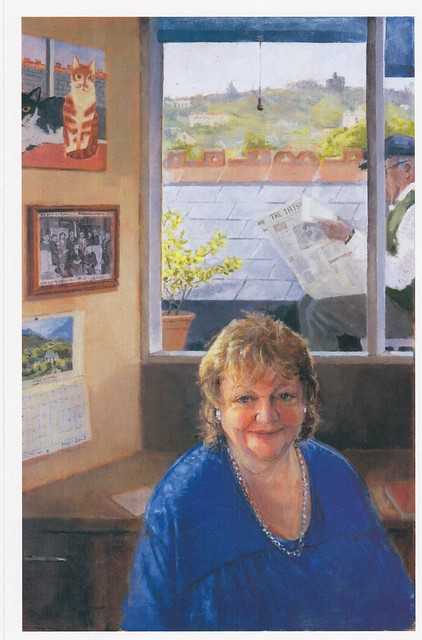
Maeve Binchy, 2005, by Maeve McCarthy, National Gallery of Ireland (source)
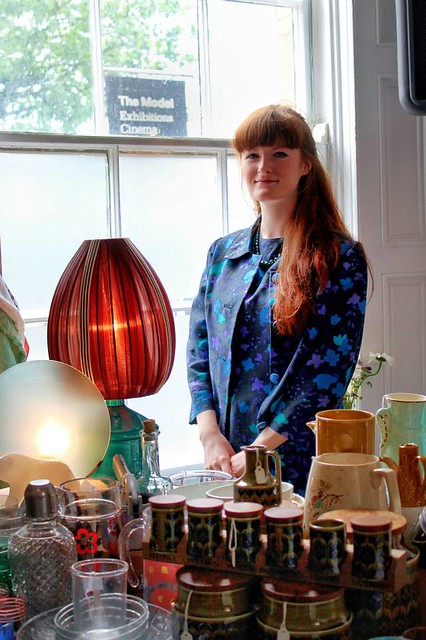
My school reports described me as a 'day dreamer', how I had potential if I only paid more attention in class. I would get in trouble for sneaking Malory Towers books and Anne of Green Gables into my Irish textbooks during class. History and English were the two subjects that firmly held my attention, I was fascinated by people from ages past or by stories of children living out lives far removed from my own, as I sat chin in hand, in that overcrowded rural class setting. Discovering vintage clothing by way of my eBay hobby was a revelation of sorts for me. It was the chance to have my head in the past, but my feet in the present (almost). I was living a day dream of sorts, imagining those who had worn the dress before me, what they'd been like and how exciting it was that 30 or 40 years hence, I shared the same taste as a girl from a decade now past. It was my own role in social history, and my preoccupation with how lifestyles have changed, but at the same time, looking back to what I imagined was a more authentic time, a social life that wasn't dictated by Facebook.
Imagine then, my sincere delight when one summers day last year, an email arrived in my inbox referencing an old blog post, in which I wore a beautiful 1960s floral silk suit. The son of the seamstress who had made the suit had found my blog via a Google alert and had emailed me to inquire about the garment, and by what circumstances I'd come by it.

Wanda Zaklika London label, other labels could read 'Wanda Zaklika Haute Couture'
The dress with the label "Wanda Zaklika London" was made by my mother, who died in 1997. It's fascinating to see the dress find a whole second life. I'm afraid I don't know who it was made for. It would have been fun if I could have given you its history. My mother's business centred around a limited group of affluent clients. The dress might, for instance, have been made for the wife of the French ambassador to London or for someone in the Bowater paper family (or some other client I cannot now recall).
My mother wasn't a designer for the mass market She designed and created clothes for a rather small number of very affluent women. She had, perhaps, 20 customers at any given time. Each piece was custom designed and made for the individual and no two pieces of clothing were alike. Indeed, since some of the women went to the same society events it would have been a cardinal sin to dress two of them the same. My childhood involved being surrounded by copies of Vogue and having to walk about carefully because of all the pins embedded in the carpet. Notwithstanding this, none of my mother's talent trickled down to me.
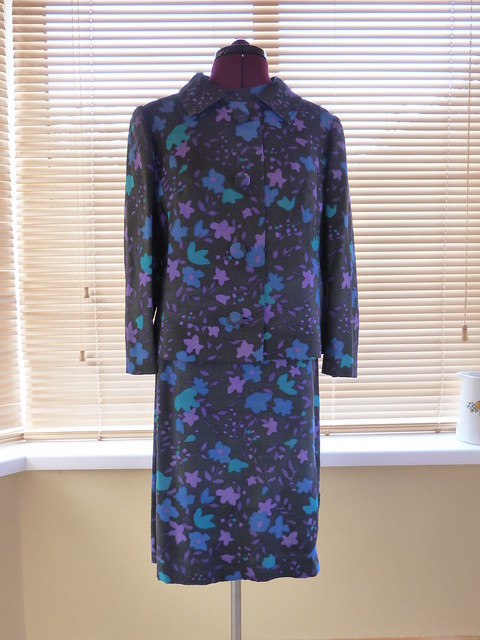

The dress is evocative of the new gaily coloured prints of the 1960s, with the large collar and buttons on the jacket in a quite conservative cut, typical of early 1960s fashions. It is all silk, the shift dress is very comfortable to wear, and was probably made for a middle aged woman, which would fit with the description I was given of Wanda's clientele. It would probably have been worn at a day event, during the summer.
The reason I was unable to find any information on the maker is because there is nothing to be found. Then as now, many seamstresses worked independently, from home, or in a studio, making dresses to order at the bequest of their clientelle. Now middle-class clients are more likely to buy off the peg, branded designer labels than have clothes made to order. For special occasions, such as weddings or debs/prom nights, we might get a seamstress to make something especially for our shape and to our taste. I was curious about the clientele of Wanda Zaklika and her son was more than happy to enlighten me ...
The sort of people who were customers were the wives of manufacturers or businessmen, members of the aristocracy (in the sense of being titled) and diplomat's wives. It was pretty much a word of mouth kind of thing and my mother never had to go out and hawk her stuff about as is the case with some designers. Given the scale of the business it is quite a surprise to see one of her garments materialize on the web.
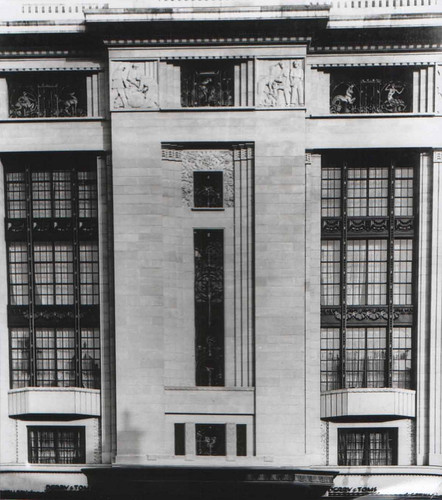
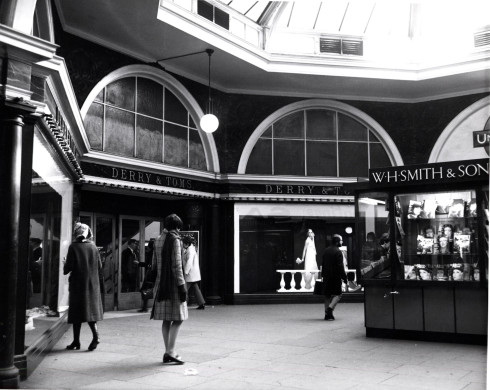
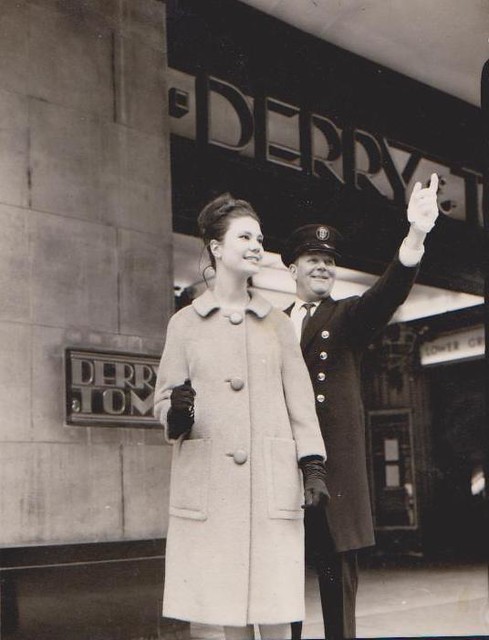
Top: 1931 picture of the art deco facade of the seven story Derry and Toms store on Kensington High Street, closed in 1971 and a couple of years later taken over by the opulent Big Biba department store for a short while (1973-75), it now houses a Marks and Spencers store. (source)
Middle: Entrance to Derry and Toms store, 1960s (source)
Bottom: Photo shoot outside for Derry and Toms catalogue outside the store entrance on Kensington High Street, 1960s. (source)
My mother purchased many of her fabrics at Derry and Toms in Kensington High Street or at Harrods in Knightsbridge. As a young child, in the absence of daycare, I would accompany her on some of these shopping trips. In exchange for being a cooperative and patient boy I was taken to Harrods toy department to drool at the toys once purchases were complete. Sadly, there were never any toy purchases since our budget would not tolerate it, but it was fun to see how the other half lived.
The dress itself, I have only worn on 2-3 occasions. It has some minor flaws such as bleach stains and cigarette burns. I had a bit of a mishap when I attempted to hand wash it and the colours ran. We assume that it was probably obtained from the sale of someones estate and potentially passed through a few people's hands before ending up on eBay, and finding its current home with me. There could be dresses under the Wanda Zaklika label marauding out there, some possibly even sold on eBay, but often if it is not a brand name, people neglect to list the maker of the item, or label information.

Wanda Zaklika as a young woman, holding a leopard cub. This was taken in pre-WWII Poland,
probably at a zoo.
Though we can't be sure about the provenance of the dress, it is a piece of a larger, fascinating tapestry, and revealed to me, the tragic beginnings of its brave, driven designer and creator.
My mother was a concentration camp survivor, having been a member of the Polish Resistance. After World War II she worked for the Polish Red Cross in Italy, looking after orphans. There she married my father, whom she had first met as a Polish POW [Prisoner of War] in Germany, and the two of them set out on their honeymoon only to be held up by Italian bandits and robbed of everything they possessed, including their clothes. Given the choice of being sent behind [the] Iron Curtain to Communist Poland or coming to England, they came to England, much of their luggage being lost in transit. There they set up their lives anew under very difficult conditions.
My mother had a degree in economics from the best business school in Poland (known by its initials SGH, and referred to in English as the Warsaw School of Economics) but her qualifications were not recognized in the UK. She began to study for a duplicate degree in Britain while simultaneously learning English. When I arrived on the scene her studies were interrupted and she began piecework sewing of shirts, something she could do to supplement our extremely modest income while looking after a baby.
Having acquired sewing skills through this and a range of subsequent dressmaking and design jobs, she set up her own couture enterprise. She acquired clients primarily by word of mouth and kept a restricted clientele so she could continue to care for me. Typically, she employed one or two people to do the finishing work on the clothes. My mother continued the business until I went off for postgraduate work, so it must have lasted for nearly two decades, perhaps from around 1955 to 1975 or so.
What an incredible story, of courage, survival and necessity. I'm glad that despite her horrifying time during the Second World War, Wanda Zaklika found success in her business, and raised a family, and I have a personal artefact to remember her by. Something I will never gain from the latest on-trend piece from replica high street stores. I feel very lucky that Wanda's son shared her unique story with me.
-
If you have a Wanda Zaklika dress, and perhaps you too found this post as a result of a Google search, please get in touch with me via my email. I'd like to put you in touch with Wanda Zaklika's son, as I'm certain he would be interested to learn where his mother's creations have ended up. Most things have a story to tell, as this happy anecdote demonstrates.
Has anyone else any similar stories to share?



















































